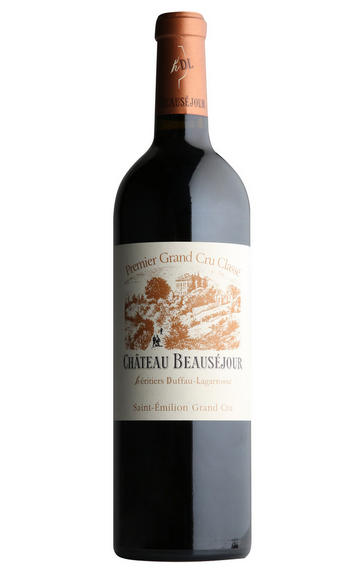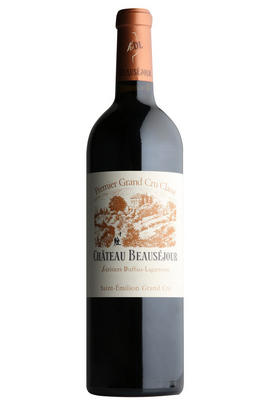
2010 Château Beauséjour Duffau-Lagarrosse, St Emilion, Bordeaux

Critics reviews
Anyone who has...visited St.-Emilion knows that this is a magical terroir capable of great things. It was only fully exploited in the past in the 1990 vintage, but has reached more consistently great heights over the last three or four years. Kudos to the duo of Nicolas Thienpont and Stephane Derenoncourt for what they have achieved over the last few years at Beausejour-Duffau.
Robert Parker- Wine Advocate- Feb 2013 Since the wunderkind team of Nicolas Thienpont and Stephane Derenoncourt assumed responsibility for this extraordinary vineyard planted on the clay and limestone southern slopes of St.-Emilion, quality has soared. The 2009 (rated 96-98+) was the greatest vintage since the estate’s prodigious 1990 and the 2010 looks to be its equal.
Composed of 73% Merlot, 23% Cabernet Franc and 4% Cabernet Sauvignon made from tiny yields of 21 hectoliters per hectare, the 2010 achieved a remarkably high 15% natural alcohol. However, the high alcohol is completely hidden by the wine’s freshness, high acids and modest pH.
A remarkable nose of blueberries, blackberries, crushed chalk, acacia flowers, licorice and truffles is accompanied by an unbelievable minerality on the palate, full-bodied power, amazing texture, a multidimensional personality and a 50+ second finish. One of the most profound wines of the vintage, this 2010 should drink well for 30-35 years or more.
Robert Parker- Wine Advocate- May 2011
Jancis Robinson MW- jancis robinson.com Apr 2011
James Molesworth – The Wine Spectator – Apr 2011
Anyone who has...visited St.-Emilion knows that this is a magical terroir capable of great things. It was only fully exploited in the past in the 1990 vintage, but has reached more consistently great heights over the last three or four years. Kudos to the duo of Nicolas Thienpont and Stephane Derenoncourt for what they have achieved over the last few years at Beausejour-Duffau.
Robert Parker- Wine Advocate- Feb 2013 Since the wunderkind team of Nicolas Thienpont and Stephane Derenoncourt assumed responsibility for this extraordinary vineyard planted on the clay and limestone southern slopes of St.-Emilion, quality has soared. The 2009 (rated 96-98+) was the greatest vintage since the estate’s prodigious 1990 and the 2010 looks to be its equal.
Composed of 73% Merlot, 23% Cabernet Franc and 4% Cabernet Sauvignon made from tiny yields of 21 hectoliters per hectare, the 2010 achieved a remarkably high 15% natural alcohol. However, the high alcohol is completely hidden by the wine’s freshness, high acids and modest pH.
A remarkable nose of blueberries, blackberries, crushed chalk, acacia flowers, licorice and truffles is accompanied by an unbelievable minerality on the palate, full-bodied power, amazing texture, a multidimensional personality and a 50+ second finish. One of the most profound wines of the vintage, this 2010 should drink well for 30-35 years or more.
Robert Parker- Wine Advocate- May 2011
About this WINE

Château Beauséjour
Château Beauséjour is a 6.8-hectare jewel long recognised for the quality of its terroir; it has been a Premier Grand Cru Classé B since the first St Émilion classification. Almost half the vineyard sits atop the appellation’s limestone plateau, another half extends down onto the côtes. This was once part of a larger estate along with what is now Château Beau-Séjour Bécot.
In 2020, the estate was put up for sale. There were many bidders; the French authorities were called upon to oversee the final decision. Ultimately, members of the Duffau-Lagarrosse family bid successfully, in tandem with the owners of the Clarins beauty group.
The estate is today led by Joséphine Duffau-Lagarrosse and Prisca Courtin-Clarins, both of whom are in their early 30s. They took the reins with the 2021 vintage, following the acclaimed stewardship of Nicolas Thienpont and his team.

St Émilion
St Émilion is one of Bordeaux's largest producing appellations, producing more wine than Listrac, Moulis, St Estèphe, Pauillac, St Julien and Margaux put together. St Emilion has been producing wine for longer than the Médoc but its lack of accessibility to Bordeaux's port and market-restricted exports to mainland Europe meant the region initially did not enjoy the commercial success that funded the great châteaux of the Left Bank.
St Émilion itself is the prettiest of Bordeaux's wine towns, perched on top of the steep limestone slopes upon which many of the region's finest vineyards are situated. However, more than half of the appellation's vineyards lie on the plain between the town and the Dordogne River on sandy, alluvial soils with a sprinkling of gravel.
Further diversity is added by a small, complex gravel bed to the north-east of the region on the border with Pomerol. Atypically for St Émilion, this allows Cabernet Franc and, to a lesser extent, Cabernet Sauvignon to prosper and defines the personality of the great wines such as Ch. Cheval Blanc.
In the early 1990s there was an explosion of experimentation and evolution, leading to the rise of the garagistes, producers of deeply-concentrated wines made in very small quantities and offered at high prices. The appellation is also surrounded by four satellite appellations, Montagne, Lussac, Puisseguin and St. Georges, which enjoy a family similarity but not the complexity of the best wines.
St Émilion was first officially classified in 1954, and is the most meritocratic classification system in Bordeaux, as it is regularly amended. The most recent revision of the classification was in 2012

Merlot
The most widely planted grape in Bordeaux and a grape that has been on a relentless expansion drive throughout the world in the last decade. Merlot is adaptable to most soils and is relatively simple to cultivate. It is a vigorous naturally high yielding grape that requires savage pruning - over-cropped Merlot-based wines are dilute and bland. It is also vital to pick at optimum ripeness as Merlot can quickly lose its varietal characteristics if harvested overripe.
In St.Emilion and Pomerol it withstands the moist clay rich soils far better than Cabernet grapes, and at it best produces opulently rich, plummy clarets with succulent fruitcake-like nuances. Le Pin, Pétrus and Clinet are examples of hedonistically rich Merlot wines at their very best. It also plays a key supporting role in filling out the middle palate of the Cabernet-dominated wines of the Médoc and Graves.
Merlot is now grown in virtually all wine growing countries and is particularly successful in California, Chile and Northern Italy.


Buying options
Add to wishlist
Description
For me Beauséjour Duffau Lagarosse is one of the absolutely outstanding wines of the vintage on the Right Bank. The big challenge in St Emilion was to retain freshness in the face of the high alcohol and high tannins, and this is a resounding success. Nicolas Thienpont, cousin of Alexander and Jacques of Vieux Château Certan and Le Pin fame, holds the reins here and the family talent is much in evidence.
Sumptuously rich on the bouquet and palate with flavours of dark chocolate, plum and berry fruits, the finish is beautifully fresh with excellent balancing acidity, and has a real sense of minerality and great persistence.
(73% Merlot, 24% Cabernet Franc, 3% Cabernet Sauvignon)
wine at a glance
Delivery and quality guarantee